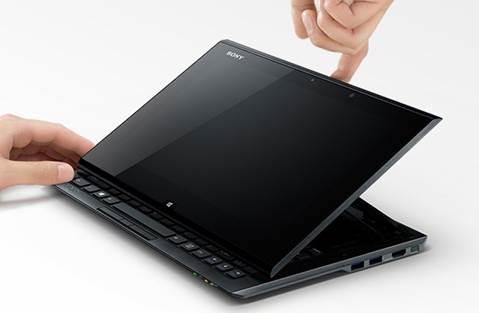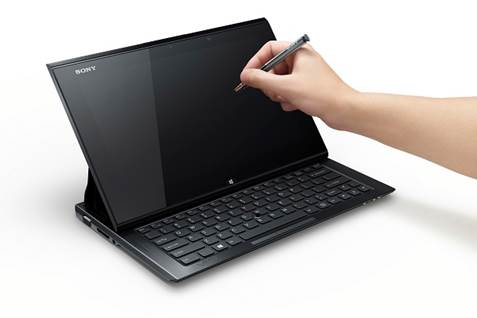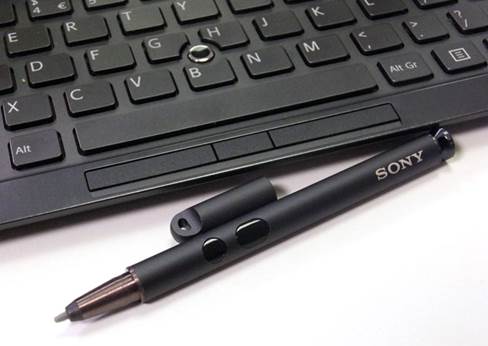Sony Vaio Duo is a type of the Windows 8
slider that falls short.
The Sony Vaio Duo 11 was one of the Windows
8 convertibles unveiled at IFA, and it stood out from the crowd of devices with
its slider form factor (slider). And it was equipped to compete with the other
versions of the 2-in-1 concept, with a choice of the Core i5 or i7 processor,
1080p touchscreen covered by the Gorilla Glass, a sturdy aluminum-alloy design
and the multiple ports. Sony also packs a stylus to navigate Windows 8 and to
do some light photo editing, in addition to a list of good features that can
justify the $1,200+.

Sony
Vaio Duo 11’s touchscreen
But the good specs is one thing, but easy
to use or not is another thing. We tested a type of computer like a slider,
Toshiba Satellite U925t, and it is unimpressive very much – it is partly due to
the design that hindered the typing experience. So, Is the Duo 11 able to do
better despite having the same form factor? Keep reading to know this.
Style and feel

With
2.87 pounds, the Duo 11 is pretty light for a convertible.
With 2.87 pounds, the Duo 11 is pretty light
for a convertible; it is not as heavy as Toshiba’s 12- inch Satellite U925t
slider with 3.35 pounds, and it weighs a bit more than the Lenovo IdeaPad Yoga
11 with 2.8 pounds. However, the 2.87-pound weight is quite a lot to handle for
a tablet; the Duo feels a little cumbersome when its keyboard is inserted. It
is 0.71 inch thick, which is just wide enough for the HDMI output, a large-sized
SD slot and a VGA port. However, it feels awkward.
Its design is also uncomfortable in other
ways. The base expands beyond the screen, so the sides of the device feel
jagged and irregular. Our thumbs usually located in the lower half of the
expansion, and this increased the weight to the fingers holding the device from
below. However, the real design quality with magnesium- alloy device body feels
very sturdy, especially compared with the plastic sliders such as the U925t and
MSI Slider S20. The Gorilla Glass-coated screen reinforces the device’s solid
feel - it is a significant feature, especially if you consider the screen is
always exposed on this computer.
When we first touched the DUO 11 at IFA, we
found that its swivel was satisfying, and while we still think the sliding
motion feels solid enough to withstand the rough treatment, putting it back on
the tablet mode feels loose more than we like. Moreover, there is one thing
that you need to study the with slider mechanism: you have to wedge your
fingers between the screen and the base to push the upper half, which is not
intuitive operation. The design also somewhat lacks elegance: there are many
things going on behind the screen, with the ribbon cables attaching the tilted
panel tilt to the base. We know: the exposed swivel system is almost predefined
with the sliders, but at least the other devices like the MSI S20 look less
cluttered.
We have mentioned the device’s a number of
ports, but let's go back and talk about them in order. Lying on the left side,
there is a VGA connector, a SD card slot and a headphone jack. A power button,
HDMI output and two USB 3.0 ports are located on the right side. Above the
screen is the 2.4MP camera and the camera rear with the same resolution is on
the flip side.
Keyboard, trackpad and stylus

When
erected in the laptop mode, the Duo 11’s screen occupies 1/3 of the keyboard
tray
When erected in the laptop mode, the Duo
11’s screen occupies 1/3 of the keyboard tray. The layout suffers from this
arrangement; small keys, but their gaps are quite wide, and they provide a
little movement. Our attempts to write a few blog posts on this device were
very discouraging, because we made mistakes every few lines. The chiclet keys
are backlighting, which is a good thing, and an expected one, relying on this
machine’s $1,200 price.
The computer’s design leads to a sacrifice
of input: no built-in trackpad. Instead, you have the left and right click
buttons with small optical pointing stick between the G and H keys. The quick
touch buttons, but like the other things on the keyboard tray, they are very
small, so you have to make sure your fingers are in the right place. We were
usually more successful in choosing the small icons with the pointing stick
than with the touch screen, but that does not mean this computer is perfect. It
is a bit too sensitive to input by accident, so the cursor will often jump
around – that is really an annoying problem especially when you are working in
a word processor. We have had several cases where the touch input did not
realize, for example in the Mafia II game, so the pointing stick is a
significant support.

With
an N-Trig digitizer stylus included, which is convenient to select items on the
screen and play a few compatible programs
You have an N-Trig digitizer stylus
included, which is convenient to select items on the screen and play a few
compatible programs. The stylus is not heavy, but heavy enough to give you a
good handle, and it identifies the pressure so you can control the width of the
strokes. We like two preset buttons that allow you to select the text or images
and erase the doodles. The trouble thing is that the Duo 11 does not have a
slot to store the pen, so it might easily be lost. Out of trouble, we found the
pen to be accurate and quick.
Sony pre-loaded ArtRage Studio Pro, a
drawing application with several different brush and pen tools and that allows
you to create the images with layers. The stylus also works with Note Anytime
for VAIO, which is a free download from the Windows Store. In addition to
providing more colors and pen strokes for drawing and writing, the program
includes handwriting recognition, so you can scribble the text and then turn it
into the typing text. As we wrote a few random statements, the application
copied all our words correctly.
Screen and sound

The
11.6-inch capacitive touch screen comes with a 1920x1080 live resolution
(190ppi) under the Gorilla Glass
The 11.6-inch capacitive touch screen comes
with a 1,920x1,080 live resolution (190ppi) under the Gorilla Glass. We
appreciate the rich pixel density here, especially when considering so many
Windows computers attached with the standard 1,366x768 configuration. Of
course, there are some exceptions to this rule - the Acer Iconia W700 and
Aspire S7 are noticeable but at this time, the high resolution screens are not
available on the Windows 8 devices. The colors really stand out on this screen,
and thanks to the IPS technology, there is a wide viewing angle. A disadvantage
of the slider form factor is the screen’s fixed angle, but fortunately, the IPS
screen is good at anti-glare.
There is a compromise with the high resolution
screen: everything looks small, even with the items sized at 125 percent which
is very annoying when you're trying to click or tap the special fields on
websites. This is when you will be extremely interested in the pointing stick
and stylus, as they prove to be more accurate than using your fingers on the
screen.
Images might not be too bad on this
machine, but the two small speakers mounted below the Duo 11 do not produce
powerful sound to match. The songs come out muffled and slightly distorted,
even though the dialogue in the film and the game prove to be more accurate. Of
course we experienced sonic fidelity and volume preferably with headphones. It
is never a good sign when we can play the song at maximum volume in a tiny
equipment room but the colleagues outside did not hear a note. Suffice it to
say that you will want to maximize the volume.